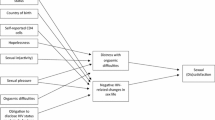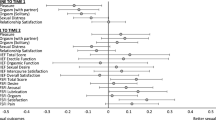Abstract
Despite the high prevalence of sexual inactivity, decreased sexual desire, and poor sexual satisfaction documented among HIV-infected individuals, women’s experiences of sexuality following HIV-infection and their reasons for these sexual changes remain little examined. Further, the potential effects of the availability of highly active antiretroviral therapy (HAART) medications on their sexuality have not been explored among women living with HIV/AIDS. To examine these issues, focused interviews were conducted with two samples of women living with HIV/AIDS: one before the advent of HAART and a second matched sample interviewed after HAART became widely available. Women in both the pre-HAART and HAART eras frequently discussed decreased sexual activity, a loss of sexual interest, and a diminished sense of sexual attractiveness following their HIV infection. In addition, they reported a number of reasons for why they had discontinued sexual activity or were no longer interested in sex, including anxiety about HIV transmission, a loss of freedom and spontaneity during sex, fears of emotional hurt, not wanting the hassle of sexual relationships, a loss of sexual interest, and a diminished sense of sexual attractiveness. However, the types of changes in their sexuality women described, nor the reasons offered for these changes, did not differ between women in the pre-HAART and HAART eras. The findings suggest that therapeutic intervention may be needed by some HIV-infected women to overcome difficulties in resuming healthy sexual relationships following their HIV diagnosis and offer insights into the potential content of such intervention efforts.
Similar content being viewed by others
Notes
Because of the unstructured nature of the interviews, this prevalence represents a conservative estimate based on those who spontaneously discussed this issue within the larger context of their conversations about their psychosocial adaptation to their illness, and should not be construed as a reliable estimate of the true prevalence of these changes in the population of HIV-infected women.
References
Bova, C., & Durante, A. (2003). Sexual functioning among HIV-infected women. AIDS Patient Care and STDs, 17, 75–83.
Brown, G. R., Kendall, S., & Ledsky, R. (1995). Sexual dysfunction in HIV-seropositive women without AIDS. Journal of Psychology and Human Sexuality, 7, 73–97.
Brown, G. R., & Rundell, J. R. (1990). Prospective study of psychiatric morbidity in HIV-seropositive women without AIDS. General Hospital Psychiatry, 12, 30–35.
Brown, G. R., & Rundell, J. R. (1993). A prospective study of psychiatric aspects of early HIV disease in women. General Hospital Psychiatry, 15, 139–147.
Collazos, J., Martinez, E., Mayo, J., & Ibarra, S. (2002). Sexual dysfunction in HIV-infected patients treated with highly active antiretroviral therapy. Journal of Acquired Immune Deficiency Syndromes, 31, 322–326.
Colson, A. E., Keller, M. J., Sax, P. E., Pettus, P. T., Platt, R., & Choo, P. W. (2002). Male sexual dysfunction associated with antiretroviral therapy. Journal of Acquired Immune Deficiency Syndromes, 30, 27–32.
Cook, J. A., Grey, D., Burke, J., Cohen, M. H., Gurtman, A. C., Richardson, J. L., et al. (2004). Depressive symptoms and AIDS-related mortality among a multisite cohort of HIV-positive women. American Journal of Public Health, 94, 1133–1140.
Denis, A., & Hong, S.-M. (2003). Sexual functioning of women with HIV: A comparison with non-HIV women. Canadian Journal of Human Sexuality, 12, 97–107.
Florence, E., Schrooten, W., Dreezen, C., Gordillo, V., Nilsson-Schonnesson, L., Asboe, D., et al. (2004). Prevalence and factors associated with sexual dysfunction among HIV-positive women in Europe. AIDS Care, 16, 550–557.
Goggin, K., Engelson, E. S., Rabkin, J. G., & Kotler, D. P. (1998). The relationship of mood, endocrine, and sexual disorders in human immunodeficiency virus positive (HIV+) women: An exploratory study. Psychosomatic Medicine, 60, 11–16.
Haas, S. M. (2002). Social support as relationships maintenance in gay male couples coping with HIV or AIDS. Journal of Social and Personal Relationships, 19, 87–111.
Hankins, C., Gendron, S., Tran, T., Lamping, D., & Lapointe, N. (1997). Sexuality in Montreal women living with HIV. AIDS Care, 9, 261–271.
Ickovics, J. R., Hamburger, M. E., Vlahov, D., Schoenbaum, E. E., Schuman, P., Boland, R. J., et al. (2001). Mortality, CD4 cell count decline, and depressive symptoms among HIV-seropositive women: Longitudinal analysis from the HIV Epidemiology Research Study. Journal of the American Medical Association, 285, 1466–1474.
Lamba, H., Goldmeier, D., Mackie, N. E., & Scullard, G. (2004). Antiretroviral therapy is associated with sexual dysfunction and with increased serum oestradiol levels in men. International Journal of STD & AIDS, 15, 234–237.
Laumann, E. O., Paik, A., & Rosen, R. C. (1999). Sexual dysfunction in the United States: Prevalence and predictors. Journal of the American Medical Association, 281, 537–544.
Lekas, H.-M., Siegel, K., & Schrimshaw, E. W. (in press). Continuities and discontinuities in the experiences of felt and enacted stigma among women living with HIV/AIDS. Qualitative Health Research.
Merton, R. K., Fiske, M., & Kendall, P. (1990). The focused interview: A manual of problems and procedures. New York: Free Press.
Meyer-Bahlburg, H. F. L., Nostlinger, C., Exner, T. M., Ehrhardt, A. A., Gruen, R. S., Lorenz, G., et al. (1993). Sexual functioning in HIV+ and HIV- injected drug-using women. Journal of Sex and Marital Therapy, 19, 56–68.
Muhr, T. (1997). ATLAS.ti: The knowledge workbench short user’s manual. Berlin: Scientific Software Development.
Schiltz, M. A., & Sandfort, T. G. M. (2000). HIV-positive people, risk and sexual behavior. Social Science and Medicine, 50, 1571–1588.
Schrimshaw, E. W. (2002). Social support, conflict, and integration among women living with HIV/AIDS. Journal of Applied Social Psychology, 32, 2022–2042.
Schrimshaw, E. W. (2003). Relationship-specific unsupportive social interactions and depressive symptoms among women Living with HIV/AIDS: Direct and moderating effects. Journal of Behavioral Medicine, 26, 297–313.
Schrooten, W., Colebunders, R., Youle, M., Molenberghs, G., Dedes, N., Koitz, G., et al. (2001). Sexual dysfunction associated with protease inhibitor containing highly active antiretroviral treatment. AIDS, 15, 1019–1023.
Siegel, K., Karus, D., & Dean, L. (2004). Psychosocial characteristics of New York City HIV-infected women before and after the advent of HAART. American Journal of Public Health, 94, 1127–1132.
Siegel, K., & Raveis, V. H. (1993). AIDS-related reasons for gay men’s adoption of celibacy. AIDS Education and Prevention, 5, 302–310.
Siegel, K., Raveis, V. H., & Karus, D. (1997). Illness-related social support and negative network interactions: Effects on HIV-infected men’s depressive symptomatology. American Journal of Community Psychology, 25, 395–420.
Siegel, K., & Schrimshaw, E. W. (2003). Reasons for adoption of celibacy among older men and women living with HIV/AIDS. Journal of Sex Research, 40, 189–200.
Squire, C. (2003). Can an HIV-positive woman find true love?: Romance in the stories of women living with HIV. Feminism & Psychology, 13, 73–100.
Wagner, G., Rabkin, J., & Rabkin, R. (1997). Effects of testosterone replacement therapy on sexual interest, function, and behavior in HIV+ men. Journal of Sex Research, 34, 27–33.
Acknowledgments
This research was supported by National Institute of Mental Health Grants R01-MH50414 and MH61148 to Karolynn Siegel (PI).
Author information
Authors and Affiliations
Corresponding author
Rights and permissions
About this article
Cite this article
Siegel, K., Schrimshaw, E.W. & Lekas, HM. Diminished Sexual Activity, Interest, and Feelings of Attractiveness Among HIV-Infected Women in Two Eras of the AIDS Epidemic. Arch Sex Behav 35, 437–449 (2006). https://doi.org/10.1007/s10508-006-9043-5
Received:
Revised:
Accepted:
Published:
Issue Date:
DOI: https://doi.org/10.1007/s10508-006-9043-5




